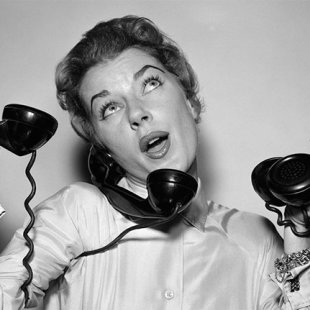(Just like in the 1950s!)
by Lylah M. AlphonseIt's like the 1950s all over again.In 1950, the most common job for women in the United States was "secretary." With fewer careers open to women back then, it doesn't come as much of a surprise that secretarial work was a popular option.
But the most-common job for women these days? It's still "secretary"—in spite of the fact that more women are earning graduate degrees than men, are rising through the management ranks, and are starting their own businesses in record numbers.
Out of the roughly 4 million secretaries and administrative assistants in the United States between 2006 and 2010, 96 percent of them were women, according to the latest U.S. Census data available. (The Census is conducted every 10 years, though data is analyzed, updated, and released at other times.) Employment data released by the U.S. Labor Department on Friday shows that the economy gained about 157,000 jobs overall in January. A report released Thursday by payroll provider ADP noted that the bulk of those jobs were in the service sector -- housekeepers, teachers, retail sales, health care workers, and restaurant workers, all jobs traditionally dominated by women -- followed by an increase in jobs in the business service industry, which would include administrative positions. Given all of the options women have today, why is being a secretary still a girl's top job?
"The most significant issue has to do with young women, women reentering the workforce, and women in career transitions still getting the advice that the best entry into a field is through an administrative position," Danna Greenberg, Associate Professor of Organizational Behavior at Babson College in Boston, told Yahoo! Shine in an interview. "We would never tell a 21-year-old male college grad that the way into a job is to start in an administrative position. But we're still, unfortunately, in this country, still stereotyping it as a fashionable place for women to start. And data shows that women don't traditionally transition out of administration positions into more white-collar work."
Though over the years career experts have warned that secretaries will become obsolete, government data proves otherwise. The U.S. Labor department predicts that secretarial and office administration jobs will grow as much as 12 percent by 2020.
"Every time a major new technology showed up, there were always predictions that this would spell the end of secretaries," former secretary Ray Weikal, spokesman for the International Association of Administrative Professionals, told CNN. "You saw that with the development of electric typewriters, the personal computer, and the internet, but every time technology gets more efficient, the amount of business increases. You continue to need people who can use those tools."
And those people tend to be women.
Money and education don't seem to be the main factors—entry level jobs in popular male-dominated fields like truck driving, manufacturing, and construction pay about the same as secretarial work (about $34,000 a year, though legal and executive secretaries earn more). It's likely that men tend to shy away from jobs traditionally held by women simply because they were traditionally held by women.
In the 1950s, the top non-secretarial jobs for women were bank teller, dispatcher, clerical worker, sales clerk, private household worker (like a cleaning lady, cook, or caregiver), and teacher. Fast-forward 60 or so years, and not much has changed: After secretary, the other top jobs for women are cashier, elementary or middle school teacher, nurse, and nurses aide.
"Even the titles may seem to exclude men," Dominique Gomez wrote in the Christian Science Monitor last year. "Society has created alternative terms for them in these professions: male nurse, male nanny, or, worse yet, the derogatory 'murse' and 'manny.' Just as policeman, congressman, and chairman implicitly excluded women, the bias against men may be built right into these professions."
But even in those fields where women dominate, they still tend to earn about 13 percent less than their male coworkers, CNN reported.
Women may also be pigeonholed into secretarial spots because of what some experts call a "boomeranging of barriers" to women in the workforce.
"Back in the sixties the barrier was that women were simply not allowed to rise in the ranks and it was a seriously rare exception when one did," Amy Richards, co-author of "Mainfesta: Young Women, Feminism, and the Future," told Forbes. "Then there was this acknowledgement that women were really needed to fill gaps in all levels of a company and so the barrier became a corporate problem. The next barrier, which is where we're stuck—and have been for the past 30 years—is the accepted idea that women really value their home lives more than their corporate lives. That they care more about work-life balance than their careers."
A need for work-life balance—or even a fear of being penalized for needing work-life balance—could push women toward clerical positions rather than management ones, in spite of increases in education levels. And a resurgence of "Mad Man" era interest may be influencing women's choices as well.
"It's really hard to watch but it actually makes us think about how far we have come. Now you couldn't get away with half of the stuff men do in the show, and women fought really hard to change that," Cindia Cameron, organizing director at 9to5, National Association of Working Women, told CNN. "It's a pretty hard time period to be nostalgic for, though."


No comments:
Post a Comment